Update! As a result of this review, Eartheasy, the North American distributor of the Lifestraw, sent me a few products to try out, and I appreciate when a company is willing to stand behind its products like that. I still feel that the Lifestraw itself is less useful than its fans make it out to be, and that the bottled version is the only version hikers and travelers should consider purchasing. I’ve given specific comments on the bottled version down below, which is worth a look as a portable filter for hiking and other outdoor activities.
As many of you may know, clean drinking water is kind of a big deal. The fact that nowadays we can get drinkable water, right at home, practically for free, is a downright revolutionary (and thoroughly recent) development, and one which remains entirely out of reach for billions throughout the world.
Enter the Lifestraw: A small, lightweight, portable, durable, relatively inexpensive filtration device that can hang around your neck like a necklace, providing you with filtered water wherever you go. It has won an endless string of accolades, and has even been called “one of the ten things that will change the way we live,” with legions of adoring fans singing its praises, swearing by its use in situations of all sorts.
Unfortunately, I think it’s bizarrely overrated.
What’s the Lifestraw?
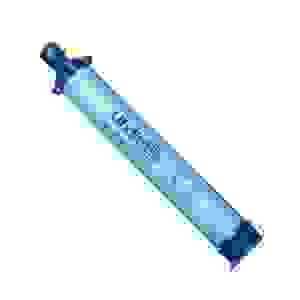
The Lifestraw is a hollow-membrane filter built into a straw. You place the straw into the water, and drink. Sucking the water up through the straw forces it through the filter, which removes 99.9999% of bacteria, and 99.9% of protozoa, down to 0.2 microns, with a filter that lasts for 1000 liters, for about $20. Not bad, right?
That’s pretty good, but on the downside, it won’t remove microscopic minerals, chemicals, or viruses.
This isn’t necessarily a deal-breaker, since most water will be fine, especially if you’re just filtering river water to avoid getting sick…but this thing was designed for the third world, with viruses all over the place, meaning you’d need iodine or other methods to eliminate the potential threat of viral diseases.
It’s certainly better than nothing, and preventing most water-borne diseases is better than preventing none. The Lifestraw was designed to provide excellent filtration at a reasonable cost, which is probably more effective than providing perfect filtration at a high cost, which could very well be too expensive to accomplish its own goals of third world disease reduction. Again, missing the viruses isn’t a deal-breaker, and it can prevent a huge number of water-borne diseases from infecting at-risk populations, but people talk about this thing like it’s the messiah of water filters.
But that’s not even the most annoying part.
The weird problem no Lifestraw review ever seems to mention
I have gone over this problem again and again in my head, looking at the endless cavalcade of glowing Lifestraw reviews, “Invention of the Century” accolades, and legions of ardent fans, and cannot fathom why no one seems to notice or care.
Take a look at the snazzy in-action shot of a guy using the Lifestraw out in the real world:
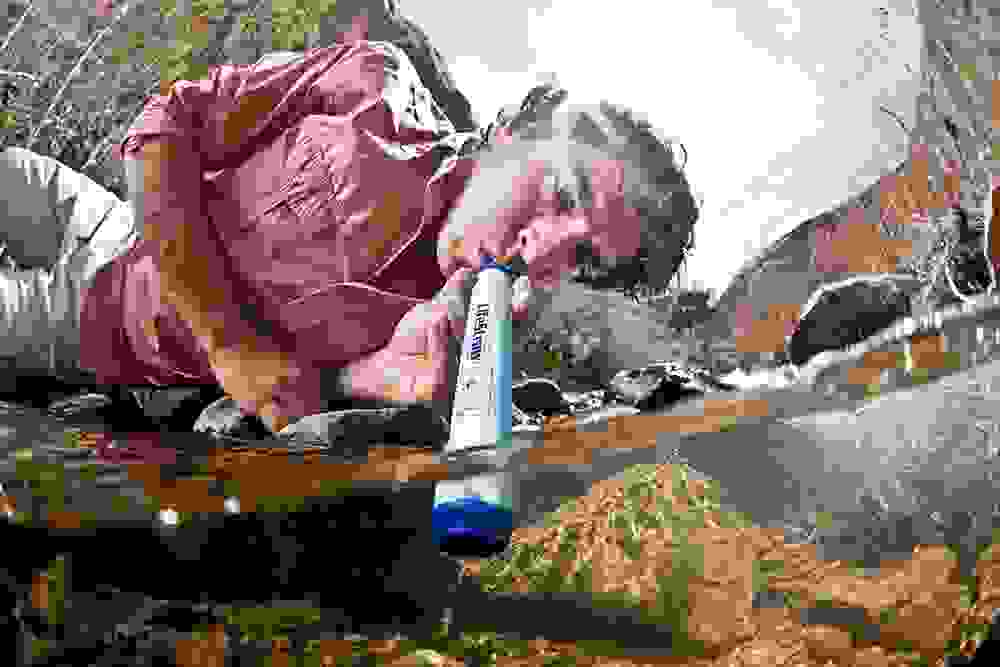
What happens when you walk away from the water?
No more water.
So if you’re heading into riverless mountains, or the desert, or a 12 hour bus ride in body-temperature heat, or any other situation in which you won’t have access to water, you’ll have to fill up a water bottle ahead of time, and whenever you want a drink of water, you have to:
- Open the bottle
- Open the Lifestraw’s top cap
- Open the Lifestraw’s bottom cap
- Stick the Lifestraw inside
- Drink
- Take it out
- Expel the remaining water
- Close the top cap
- Close the bottom cap
- Close the bottle.
And then…you’ve got a wet Lifestraw, so you’ll probably end up with wet clothes. Sexy!
People talk about how “simple” this is, as if handling three caps instead of one is somehow…simple?
On a related note, imagine traveling with this thing, and trying to fill up from a sink. You’d have to plug the sink, fill it up, wait for it to get deep enough to drink, then take a few sips, unplug the sink, and walk away. Imagine being incredibly thirsty and trying to do this in a hurry. Now imagine you’re about to get on a 12 hour bus ride through midday temperature highs, and all you had ahead of time was a quick sip from the sink, and that’s all you’ll have until the next time you get to another sink, when you’d begin the sink plug process anew. Just for one sip.
Seriously, has anyone actually used this thing?
What the Lifestraw should have been
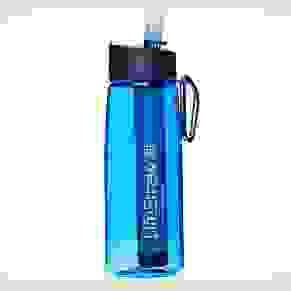
So here we finally are, at a product that’s actually recommendable. The Lifestraw Go. They took the Lifestraw and stuck it inside a water bottle, which eliminates the pointless inconvenience of only being able to drink with water nearby, or having to deal with three different caps and two separate objects for every sip.
But damn…the Lifestraw has been around since about 2005, and this bottled version only started shipping around 2013. This means that for 8 long years, nobody ever bothered asking “Dude, what if you walk away from the river but you’re still thirsty?” Sigh.
This bottled version was designed for the consumer market, which makes a lot of sense, and it’s true that shipping a million regular Lifestraws to disaster zones or poverty-stricken rural areas is logistically easier than shipping a million bottled Lifestraws, as they’d need maybe 5 or 6 times as many shipments due to the size, but damn…how does anyone use the regular one more than a few times without going crazy?
While it’s true that the original Lifestraw was designed for simplicity, portability, durability, and ease of use (and somewhat succeeds), I just can’t see many good reasons not to stick it inside a water bottle in the first place. Particularly from a consumer standpoint, the bottled version is clearly the correct answer here.
Update: I can think of ONE situation in which the straw by itself might be more useful than a bottle: Trail running, near a river. You can strap it to your leg, so it doesn’t bounce around, and you’re always near an outdoor water source, which would only need this type of filtration, and wouldn’t need a bottle.
But, ranting aside, is it a good filter? Is it a cost-effective solution to commonplace water purification needs, third world or otherwise? Could this be the one and only water purification method you employ, whether hiking in the mountains, or adventuring throughout the developing world?
Well…maybe.
Remember, it still can’t filter viruses, which is what you’d want in developing countries.
That’s not to say it’s not useful. A $35 water bottle that provides 0.2 micron filtration which lasts for 1000 liters certainly isn’t bad.
But on the other hand, you can just get the Sawyer Water Bottle, which manages 0.1 micron filtration for a guaranteed 3.7 million liters for a one-time cost of $50.
Um…tell me again, why is the Lifestraw so popular?
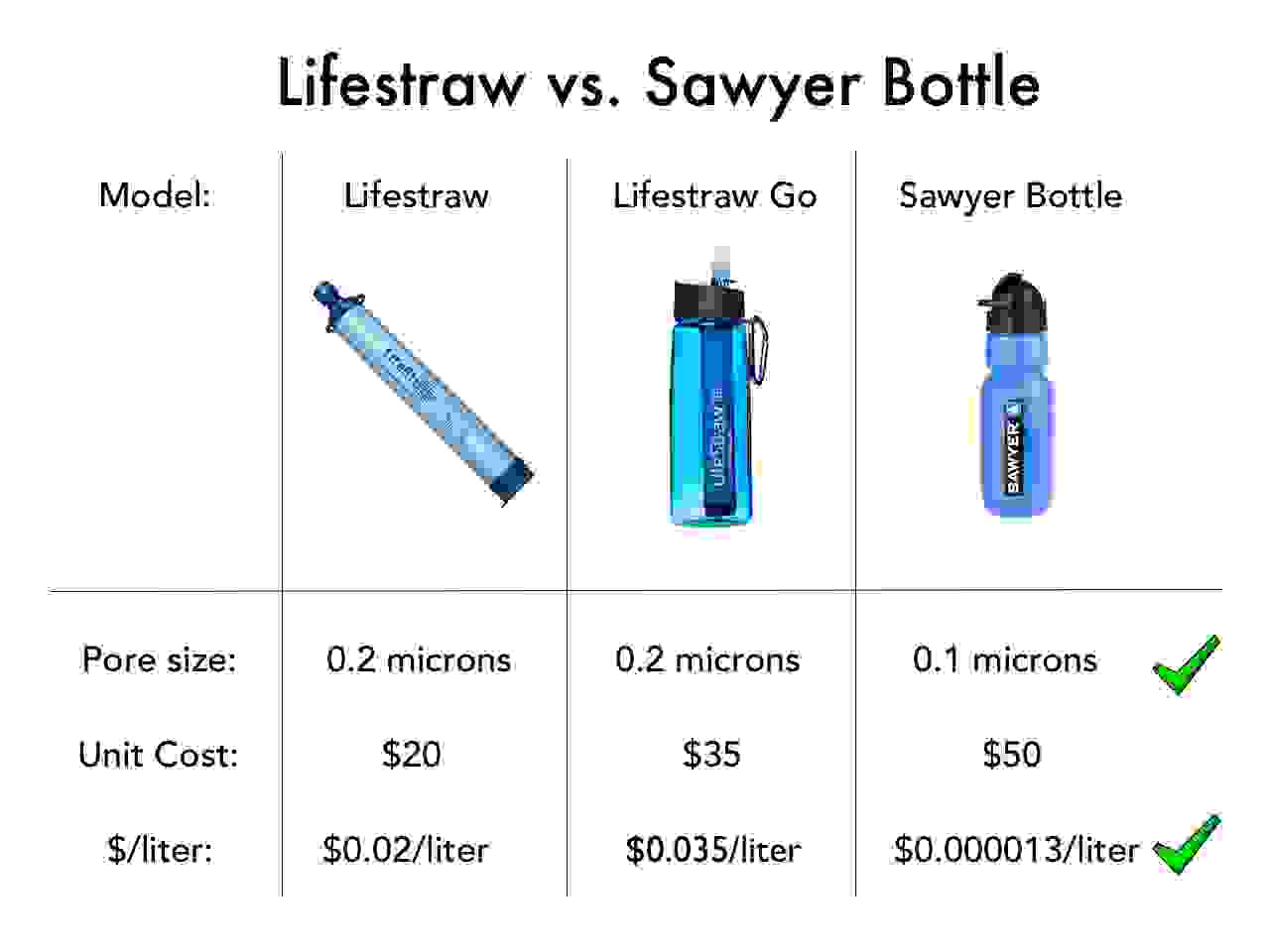
It has been claimed that the Lifestraw’s lifespan estimates are intended to be a little on the safe side, using low-quality water for all of its tests, which is good (and Sawyer’s lofty claims were put to the test, and were sadly shown to come up short, so the performance difference is likely to be smaller than what is claimed). And again, it’s not that it’s bad, and the filtration quality will probably work just fine if you’re hiking in North America, and you could supplement it with iodine tablets if you ever take it with you to Mexico, or wherever else you might want anti-viral protection. And if you’re drinking a liter of water per day, a $35 Lifestraw Go will last almost 3 years, which isn’t bad at all, and if you’re only using it for camping trips on weekends, it’ll last much longer. I also think it looks nicer than the Sawyer. So it’s definitely good; it’s just not necessarily the best, neither on filtration quality, nor on cost-effectiveness.
Update: After receiving and using the Lifestraw Go, I can say that it’s a pretty good product for hikers who plan on filling up from a river and just want a simple water bottle filter to do the job. Its filtration performance isn’t as strong as the Sawyer, nor is it as cost-effective, but it’s still effective and affordable, for non-viral filtration. Keep in mind it’s supposed to filter biological contaminants rather than chemical, meaning it’s more suited to filtering clear river water than tap water, which is more likely to have chemicals of some sort.
Two issues: Firstly, the Lifestraw Go does not use the regular Lifestraw as a replacement filter, but instead uses a slightly modified version. This means you cannot replace the filter inside the Lifestraw Go with a regular Lifestraw, and, at the moment anyway, you cannot buy just the replacement filter by itself. When your Lifestraw Go reaches the end of its life, you’ll have to buy an entirely new bottle. I expect that if the product is successful that they will offer those replacement filters by themselves, but it’s worth being aware of this issue.
Secondly, when the bottle is shut and the straw is folded down, it protrudes slightly beyond the edge of the lid, and it’s easy to get your grubby hands all over the straw when you pick up the bottle, potentially getting the straw a little dirty and thus defeating the purpose of drinking filtered water. This could be easily fixed, and I hope they do it. Second update: THEY DID!
If you think it’s for you, check it out here.
But again, neither of these devices will provide chemical or viral filtration. If you want to get rid of viruses, then you’ll need iodine tablets, or a UV light, or upgrade to a water bottle that actually gets rid of viruses, too.
What if I need serious purification?
For most people, high-quality filtration works just fine. If you’re hiking in North America or filtering tap water while traveling through modern countries, you probably don’t need virus removal to be safe. But if you’re traveling in developing countries with incredibly questionable tap water, you might want to take some extra precautions.
And yes, you can fit a whole purifier right inside a water bottle, like these do:
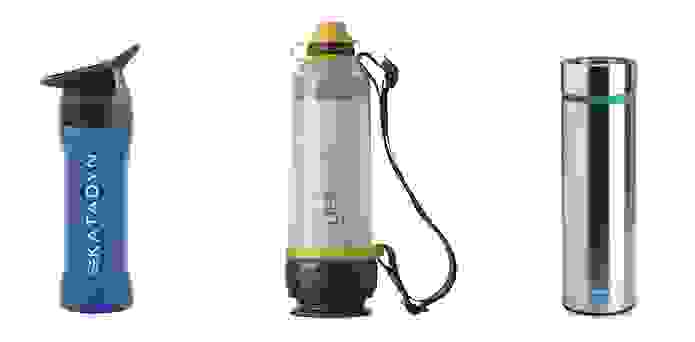
Each of these will clean out viruses, along with all the other contaminants, including chemical, that you’d want removed, providing thorough filtration beyond anything the Lifestraw can manage. Check out a thorough review of those three, including short and long term cost estimates, and suggested uses for each. They all work differently, without any objectively “best” option, so you’ll want to find a favorite that works for you. I’m currently using the GRAYL, which manages the nice trick of allowing multiple options for filtration quality as needed, and also looks nice and classy.
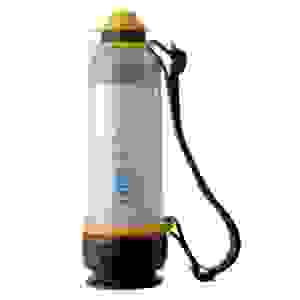
But I’d also like to highlight a close competitor to the Lifestraw, one which shares the design goal of providing high-quality, portable, durable water filtration to vulnerable populations in the third world, and which demonstrates what the Lifestraw could have been. It’s the Lifesaver Bottle, and it’s 13 times better.
The pores in the Lifestraw are 0.2 microns, whereas the pores in the Lifesaver are 0.015 microns, making them about 1/13th the size, which is small enough that viruses can’t get in. No more worrying about having to use iodine tablets.
It’s true that the Lifesaver is bigger, heavier, bulkier, and significantly more expensive (though long-term costs are actually quite good), whereas the Lifestraw was supposed to be so tiny and portable that you can take it with you wherever you go, which might actually mean it gets used more frequently by those who don’t want to bring along a bottle all the time. But…if you need a bottle anyway, and you want portable virus filtration, the Lifesaver wins.
Yet nobody seems to know it exists.
So why does everyone love the Lifestraw?!?!
Well, I don’t really know. It was even called the “Invention of the Century,” from a publication I otherwise enjoy, despite lower performance and higher long-term cost than competing options that have been on the market for years.
Again, it’s not bad, and the bottled version solves quite a bit of the silly ridiculousness of the straw-only version, but everyone adores the straw-only version, as a consumer product, which is absolutely inexplicable to me.
But I have a theory:
At $20, it’s cheaper than many other filters, and, admittedly, its filtration capability is pretty good, and a lot better than most of what I’ve seen for the same initial cost. It has a nice impulse-buy price point that gets people interested, and its unique design sets it apart in a world of filtered pitchers, faucet adapters, and so on. And when it arrives in the mail, people give it a try, drinking from a cloudy glass of water, and impressing some friends. Buyers are left happy.
And then they never use it.
Seriously. If you read the Lifestraw reviews on Amazon, you’ll see lots and lots of people talking about how great it is, who stuffed it into an emergency preparedness kit and never bothered with it again. They’re rating the product on how cool they think it is, not how practical it is in real-world use.
People actually love it so much that they videotape themselves drinking from jars of water full of feces…which is explicitly something the Lifestraw cannot handle, because water contaminated this way can easily have viruses inside, which the Lifestraw is incapable of removing. There’s a level of enthusiasm for this product that is literally dangerous.
So is the Lifestraw useful at all?
I would like to clarify that I am examining the Lifestraw from a consumer standpoint, rather than from a disaster-relief or third world disease alleviation product. It offers plenty of functionality in those situations, especially the Lifestraw Family, which is a larger (though still portable) filter intended for home use that does remove viruses. Most of my annoyance should be directed toward the overrating fanboys, who post videos of people drinking toilet water, and then resort to third-grade name-calling if anyone ever criticizes its performance or design.
So it’s certainly not horrible, particularly the bottled version, which is the only one you should bother looking at. Its filtration capability is actually quite good, and it’s pretty convenient. I just think it has been played up way too much in the media, and people salivate over it like it’s this work of art that no disaster-preparedness kit should ever be without.
Just remember that it is incapable of handling chemical and viral contamination, meaning you should only use it within a narrow band of circumstances; outdoor recreation, in North America (and similar settings), where the water you come across has neither chemicals nor viruses.
So it’s certainly worth a look, but I can’t say it’s the best. Competing products provide better filtration at a more cost-effective price, while other devices handle viruses as well, which is what you’d want in developing countries.
Check it out, but remember to…filter some of the adoration.




You could just carry an empty cup with you. Laying down on your belly is quite much. Having an empty cup to scoop water wouldn’t be a hassle. Problem solved, damn I’m good!
That still just leads me to prefer the bottle. I just can’t see a better way…
Good lucky carrying a cup of water as you’re hiking up a mountain!
Informative and entertaining… Thank you!
What do you think about radio-logical filter products?
http://www.clearlyfiltered.com/products/radiation-filtered-water-bottle/
http://www.goaquagear.com/products/r1-radiological-water-filtration-straw
http://store.seychelle.com/Products-Radiological.html
Seems useful if you have to deal with these sorts of things, but I would imagine most people wouldn’t need to spend the extra money. People working in a facility that deals with those materials might want to think about it, though.
Do you check out the testing claims for any of these products. I sure would hate to buy a product and later find it does not do what it claims. I don’t want to name the product, but I thought I found a great $20 deal at amazon which would fliter the water and take out the heavy metals. They claim in the answer section the item is certified having a ” Gold certificate from the Water Quality Association, United States and Tested by TUV SUD against ISO 9001:2008″
I have checked these associations on the internet and do not find the company or the product name for this China based product. I don’t want to name the product since it is possible I may not be searching properly. Have you come across any misrepresentations?
Removing metals is actually quite easy. Any carbon filter will remove chemicals and particles like these, and those are pretty cheap. Camelbak makes one called the Groove, but keep in mind this is just for tap water, and won’t do anything for bacteria or viruses. But yes, it’s possible to do a simple filter at this level of quality for $20. But it’s also possible that other options exist with faulty claims. If you’re worried about this sort of problem, I’d look at established brands, since they have millions of people using their products, and it would be illegal, and very noticeable, for them to be making stuff up.
I would not find it a problem carrying a water bottle along. Most outdoor stores sell water bottles anyways. And most hikers, campers and canoeists would have brought along their own bottle they already have.
So if you need a drink, just dunk your bottle into the water source and use the lifestraw to drink from your bottle.
Love the review. Great info about water filters in general. Im a proud owner of a Lifestraw and I love it. The downfall to it though is like you said, you cant go far from water without a bottle. It is a hassle to go through so many steps to get a drink from the creek or a bottle. Cant tell you how many times I’ve soaked my shirt to get water lol. That being said, I usually carry a 2 liter hydro backpack with me. Do you have any recommendations for a hydro pack filter that maybe hooks up to the mouth piece. Thanks for taking the time to write this article.
Yup, it’s called the Sawyer Inline Filter and it works great. You stick it into the hydration bladder’s hose and that’s all. It doesn’t connect to the mouthpiece end; it attaches anywhere along the hose, but it’s most convenient when it’s near the bladder itself, since you just stuff them both into a hydration sleeve and you’re done, and it works as conveniently as a regular hydration bladder, except it’s a filter as well. I suppose you could hook something up to the mouthpiece, but I think this is easier anyway.
I spend almost ALL my outside time near water…as many outdoor enthusiast do. Whether I’m fishing, kayaking, canoeing, paddle boarding, hiking, camping, it’s nearlly all done near water. Your review is almost comical in its disregard for this very large, active group of water junkies…for us, this is perfect, especially when wieght and space are factors too. I have no problem with the bottle and can see it being a great product also but your review is a little to snarky for my thirsty palate.
Thanks the page. I’ve now read it twice on two different occasions when researching bottles. We did make an impulse purchase of the LifeStraw and then tucked them in an emergency kit… *then* went about research bottles for an upcoming trip overseas.
P.S. – The LifeSaver is 1/13th the size, not 13x smaller. :-)
I haven’t seen any reference to the stats that Lifestraw give that the filter is .02 microns, not 0.2 as you’ve stated in your original article. BIG difference.
http://www.jadavey.com.au/lifestraw/
Nomess
The Lifestraw and Lifestraw Go have filters of 0.2 microns; the Lifestraw Home and Lifestraw Family (larger, countertop-sized appliances) have filters of 0.02. Those are good.
Since I will be living in China for a few months, and knowing how problematical tap and bottled water are there, I have been reading a lot about portable filtration methods. I will be taking a couple of Lifestraws with me for drinking even purchased bottled water as regulations are inconsistent and water company scandals have been many in recent years.
I have read several posts here but have not found discussion of the Berkey filter which claims to eliminate dissolved solids, bacteria and other chemicals. I am also taking a Berkey shower filter even though I know they are sold there. Any comments?
The Berkey’s filter bottle claims don’t mention viruses, although in larger Chinese cities I wouldn’t worry about that. The reviews are pretty mixed based on how hard it is to drink out of it, and how the seal can occasionally leak, which…come on, guys…it’s 2015. Can we not make water bottles that don’t leak? Oh well. Aside from that, it seems like it would work well enough. Check out the Water To Go Bottle, or anything on this page for more options.